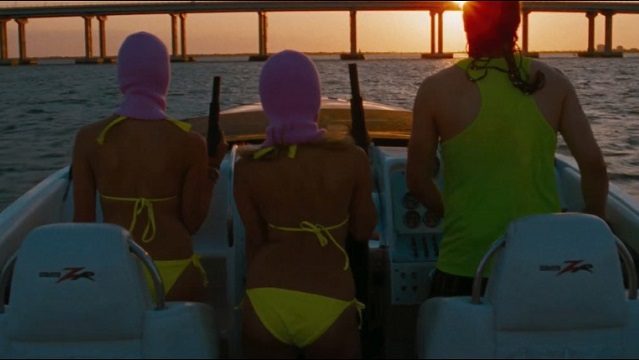Back in 2003, Harmony Korine unleashed a day-glo collision of every type of “dangerous” pop culture, simultaneously critiquing the messages delivered to our youth and mocking the critiques. Three years of current events have not been kind to Spring Breakers. Or, perhaps they’ve been exactly what the movie needed to place it in its properly ironic context. After 2 years of Black Lives Matter, the immediate context of our existence has soured Spring Breakers‘ ironic glorification of white privilege, violence and cultural appropriation.
Spring Breakers opens with slow motion objectification of topless women getting beer drizzled onto their breasts as Skrillex screeches over the soundtrack. It’s a hyper-stylized version of the Girls Gone Wild commercials that used to dominate Comedy Central’s late night advertising and whose DVDs seemed to pop up in every fraternity (everyday women would get drunk and show off their tits for little to no money while some total douchebag profited from the DVD sales). This all gets undercut by the actual story of four college women imitating video games and outlandish vacation videos by robbing diners while wearing ski masks so they can go down to Florida for spring break where they have drug and alcohol-fueled orgies with other mostly-naked college students.
After the girls get arrested, they’re broken out of jail by James Franco’s Alien, a white drug dealer and rap artist who obsesses over Brian DePalma’s Scarface. Suddenly, the very white privileged world becomes very black…except for Alien and the girls. All of the “safe” white hedonism where the girls are prancing around half-naked while blown out of their minds is replaced by a hip-hop-centric exoticism that takes on a menacing tonality just because of a skin tone change, even if the girls are fully dressed, sober, and not being pressured by anybody. The gang war of the third act has its origins in rap videos and white fantasies of black drug dealing life.
After two years of watching unarmed black people murdered by police on television, Spring Breakers takes on a sadistic undertone. These four women and Alien are able to jump into drug dealing and raging violence with little consequence, while they automatically judge black men as predators without even talking to them. They hold up a diner for money, smashing up the counter with a hammer, but they still have room to judge people by the color of their skin. With this dichotomy, Korine is highlighting the ironic appropriation of a minority’s culture without acceptance of the people who created it. Rap is fetishized as dangerous, but separate people develop a fear of the other.
The beauty of Spring Breakers is that it it has its cake and it eats it too. Korine falls into the trap of trying to critique a critique of a culture by creating a cartoonish hyper-elevated version of the culture that’s being critiqued. And, as such, it works as the most gloriously toxic example of everything we fear while holding every viewer in contempt.
One way Spring Breakers still works, however, is in its cinematography and editing. Korine hired Gaspar Noe’s regular cinematographer Benoit Debie, and editor Douglas Crise (who would go on to edit Birdman) to create an eye-gougingly gorgeous concoction of toxic neon and rampant nudity set to the most obnoxious dubstep this side of the Electric Daisy Carnival. It’s so gorgeous, any contradictory faults it contains can be overlooked to a point.
Spring Breakers airs on Showtime at 9:30pm.

